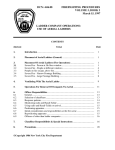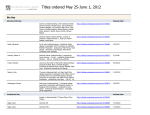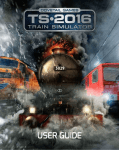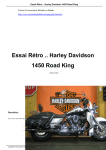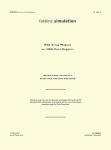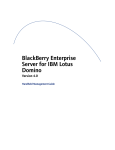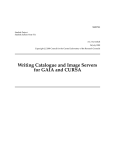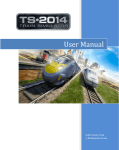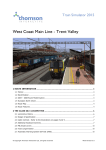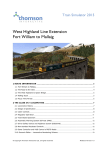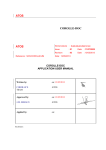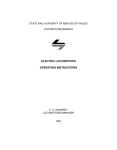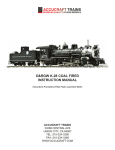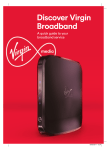Download Untitled - Virtual Rail Creations
Transcript
The Prototype Locomotive In 1966, General Electric introduced the railroading world to the U30C road switching locomotive. Although it was designated as a new model, the locomotive was actually just a souped up version of the not-so-popular U28. Turbocharged to 3,000 horsepower, the first units off the production floor were externally identical to the earlier model. When applied to locomotives, the term "Phase" is more of a rail fan term that is used to denote marked differences in locomotive construction or spotting features. The U30C had two distinctive design phases. The first, which is represented in this package, was built by GE from 1966 to 1968. The spotting features, both inside and out, are as follows: - Rear radiator section does not extend vertically to the deck. - Extra cooling tower on top of the standard radiators. - Front flip-up step - no anti-climber. - GE-proprietary KC-99 Master Controller. - Nasal toilet facilities. At the time of it's introduction, GE was a distant second in locomotive production behind General Motors. GE locomotives were prone to breakdowns and electrical problems, so railroads generally stayed away from them. The U30C did nothing to alleviate buyer's remorse, as the early units were just as unreliable as their predecessors. However, GE picked up sales for the new model simply because GM could not fill the orders it had for it's locomotives fast enough. And later improvement to the U30C would set the stage for a battle that would end GM dominance of the American diesel locomotive market... BUYERS 606 U30C locomotives were manufactured during the roughly ten or so years of it's production. However, only 39 could be classified as Phase 1. The primary P1 buyers were: - Reading - Delaware & Hudson - Chesapeake & Ohio - Pennsylvania Owners of the U30C Phase 1 through aquisition or aftermarket: - Penn Central - Conrail - Chessie System - CSX THE GENERAL ELECTRIC U30C FOR TRAINSIMULATOR This package features CSX Transportation licensed paint liveries, and contains the following downloadable content for use with the TrainsSimulator 20xx PC and video game: U30C Phase 1: Conrail U30C Phase 1: Chessie System 40' Air slide Hopper, Chessie System 100 ton Hopper, Chessie System - C&O (re-issue) 100 Ton Hopper, Conrail Quick Drive scenario for each locomotive. Career Scenario: U30C King Coal: Move em’ in. Career Scenario: U30C King Coal: Load em’ up. Career Scenario: U30C King Coal: Shoot em’. Repaintable Exterior .PSD files for creating re-skins. Installation 1.) After downloading the VRC U30C Primary Pack, check the package for viruses and Mal ware using the scanner of your choice. 2.) Unzip the package to a directory of your choice. 3.) Open the RW Package Manager. 4.) Click on the “Install” button and navigate to the folder where you unzipped the U30C package. 5.) Click on the .RWP to install it. Scenarios NOTE: These scenarios are set on the NS Coal District route, sold separately by DTG/RSC. The settings and outcomes of these scenarios are complete works of fiction. U30C King Coal: Move em’ in. Power plants in the South are hungry for anthracite coal, like the kind that is produced by the Bailey Mine. Take a string of empties on a run-through agreement to pick up the black gold. U30C King Coal: Load em’ up. Got an afternoon to spare? Fire up this grinder and test your skills at loading a 99-car coal train. U30C King Coal: Shoot em’. Get the loaded train back to the Alicia loading docks. Quick Drive Scenarios Each locomotive is enabled for Quick Drive. Simply click on the Quick Drive tile in TrainSimulator and select one of the locomotives and a route to run it on. Creating Your Own Scenario These instructions are for creating a simple free-roam scenario using the U30C and VRC freight cars. If you want to create a more sophisticated scenario or add special instructions you should consult the TS2014 user manual. - After opening the Scenario Editor for the Scenario and Route of your choosing, click on the Object Filter pane (left middle pull-out). - Click on the Provider Filter (box with arrow on it) to bring up the filter box (right-side pullout) - Scroll down through the list of providers and make sure that "VRC" is checked, as well as U30C-Series. - Return to the object filter and click the Locomotive icon. - Scroll through the list and choose one of the available U30C locomotives. - Place the locomotive on the tracks as many times as desired. - Add VRC freight cars to the consist. - Place a driver icon on the lead locomotive. - Press F2 to save the scenario, then close it out. - Once in the actual game, click on the locomotive to select it as your player avatar. Features and Controls Exterior Features: Feature Cab Keyboard Mirrors Right Yes Ctrl+N / Ctrl+Shift+N Mirrors Left Yes Ctrl+M / Ctrl+Shift+M Windows Engineer Yes N Windows Conductor Yes M Door Engineer Yes Shift+N Door Conductor Yes Shift+M 4. Start Compartment Yes Shift+V 5. Engine Compartment No Ctrl+V 6. Horn Yes Spacebar 1. 2. 3. HUD Yes Game Pad Feature Cab Keyboard HUD Front Headlights Yes H (Dim/Med/Bright) Yes 2. Front Number Boards Yes K 3. Class Lights Yes C Ctrl+C 1. Shift+H to decrease Increase Class Shift+Ctrl+C DecreaseClass 4. Front Kickstep Yes Ctrl+K 5. Front Uncouple Lever No Shift+U Game Pad 1. Feature Cab Keyboard HUD Rear Headlights Yes Ctrl+H (Dim/Med/Bright) Yes Ctrl+Shift+H to decrease 2. Rear Number Boards Yes Shift+K 3. Rear Class Lights Yes Shift+C Ctrl+C Increase Class Shift+Ctrl+C DecreaseClass 4. Rear Kickstep Yes Ctrl+Shift+K 5. Rear Uncouple Lever No Ctrl+Shift+U Game Pad 1. Feature Cab Keyboard HUD Locomotive Brakes Yes [ Yes Increase ] Decrease 2. Bell Yes B Yes Game Pad Interior Features: Feature 1. Unit Number 2. Speedometer 3. Sun Visor Cab Yes Keyboard HUD Game Pad Feature 1. Ammeter Gauge 2. Main/EQ Reservoir Gauge 3. AFM Gauge 4. Reserve Air Gauge 5. Selector Cab Keyboard Yes Ctrl X Decrease HUD Shift X Increase 6. Power Lever Throttle Selector must be in 1 to use the Throttle Yes 6a. Power Lever – Dynamic Brake Selector must be in B to use the Dynamic Brake Yes 7. Reverser A Increase Yes D Decrease Yes See notes below about using the Selector ./ Power Lever. Yes W Increase Yes S Decrease 8. Front Headlight Switch Yes Generator Field Switch Yes 10. Rear Headlight Switch Yes 11. Crew Call Button Yes 9. H Increase Shift+H Decrease Ctrl+H Increase Ctrl+Shift+H Decrease Yes Game Pad 12. Console Lights Yes 13. Notch 7 Power Limit Switch Yes Emegency Brake (Not Shown) Yes Backspace Handbrake (Not Shown) Yes Shift+/ Yes Special Note about the Power Lever handle: The Power Lever handle is capable of supplying power to both the Throttle and the Dynamic Brake, but not both at the same time. For proper operation, you must set the Selector to the proper setting – 1 For Throttle, B for Dynamic Brake, Off for trailing unit. Then depending upon which Selector setting you are using, you must use the proper area on the Power Lever to administer the control. The bronze end of the handle is used when applying power to the Throttle. The green area of the handle just to the left of the bronze is used when applying the Dynamic Brake. The Selector should prevent both controls from being active at the same time. Still, if you try to use the Dynamic Brake when the Throttle is active, or the Throttle when the Dynamic Brake is active, unexpected train handling situations may occur, resulting in loss of control or derailment. Selector in the “Off” position Selector in the “Dynamic Brake” position Selector in the “1” or “Run” position Feature Cab Keyboard HUD 1. Horn Yes Spacebar Yes 2. Train brake Yes ; Increase Yes ‘ Decrease 3. Brake Cutout Yes 4. Independent Brake Yes [ Increase ] Decrease Yes 5. Sander Yes X Yes 6. Bell Yes B Yes Game Pad Feature Cab 1. Light Switch Yes 2. Wiper Switch Yes Keyboard HUD V Yes Game Pad OTHER CONTROLS 1. Battery Engage Switch - Local Control - Turbo Control - Fuel Pump - Auxiliary Gen Field - Tran Control - Auto Water Drain - Cab Heat - Module Control - Reverser Control - AC Control - Brake Trans Control - Gen Field - Auxiliary Blower Motor - Auxiliary Generator Feature Cab 1. Engine Run Yes 2. Charging Circuit Yes 3. Lights Yes 4. Headlights Yes 5. Control Yes 6. Fuel Pump Yes 7. Electronic Devices Yes 8. Utilities Yes 9. Radio Yes Keyboard 10. Safety Devices Yes 11. Warning Devices Yes 12. Front / Rear Number Boards Yes K / Shift K 13. Class Lights Yes C / Shift C 14. Engine Start Yes 15. Engine Stop Yes 16. Platform / Engine Room Lights Yes 17. Isolate Switch Yes 18. Ground Fault Reset Yes HUD Game Pad STARTING ENGINE Simple Mode NOTE: Simpleton Mode and Gamepad controls are not officially supported. Locomotives are complex machines and should be treated as such by train games and simulators. 1). Press the “Z” key on the computer keyboard. This will throw all necessary switches into their “On” positions and start the locomotive. It may be a minute or more before the locomotive gains full power; wait until the engine has attained 450 RPM before operating the unit. Intermediate Mode 1.) Press the “Engine Start” control on the rear control panel. This will throw all necessary switches into their “On” positions. However, you will need to check your auxiliary switches (Lights, Headlights, etc.) to be sure they are on. Wait until the engine has attained 450 RPM before operating the unit. Expert Mode Before attempting to start the locomotive: 1). Move the Engine Control switch to the “Start/Isolate” position. 2). Close all switches and circuit breakers in the battery switch box. 3). Engage the following breakers on the rear control panel: a. b. c. d. e. f. Engine Run Charging Circuit Control Fuel Pump Headlights Lights (Running) 4). Once these controls are active, move to the first set of doors at the engine compartment. Open them and locate the “Prime / Start” box. a. Turn the knob to Prime in order to begin pumping fuel to the engine. The prime will automatically stop when enough fuel is present. NOTE: holding the Prime switch for more than 20 seconds could cause flooding. If this happens, the engine cannot be started for two minutes after returning the switch to the OFF position. b. Turn the knob to Start. If the proper starting procedure has been followed, you will hear the engine kicking over within 10 – 15 seconds. 5). The engine has a delay at startup of 10-20 seconds before it begins to generate power. Do not attempt to operate the controls of the unit before this delay is over. Note to Scenario Developers: By default, the U30C locomotive is unpowered at the start of a scenario. If you wish to have the locomotives start automatically at the beginning of a scenario without user input, then you need to insert the following code into your scenario script and link it to the scenario through the Timetable Editor: if event == "boarding" then SysCall ( "PlayerEngine:SetControlValue", "ShortcutStartup", 0, 1 ); return TRUE; end In the first line, “boarding” is a name that links the script command to the Timetable Editor. A simple message trigger with this name placed in it is usually enough to start the locomotive. You could also use the timestamp to trigger the startup later, or include a message to the player. ENGINEERING Simple / Intermediate Modes 1. Place the Reverser in the forward or reverse position. 2. Move the Train and Independent braking lever to release. 3. Move the Power Lever to the desired position to begin moving the locomotive. Expert Mode 1. 2. 3. 4. 5. 6. Move the Engine Control switch on the rear control panel to “Run”. Place the “GenField” switch on the Master Controller in the “on” position. Place the Reverser in the forward or reverse position. Place the Selector handle in the “1” position. Move the Train and Independent braking lever to release. Move the Power Lever to the desired postion to begin moving the locomotive. Dynamic Braking The Power Lever doubles both as Throttle and Dynamic Brake. To use the Dynamic Brake, do the following: 1. 2. 3. 4. Move the Power Lever to the “Idle” position. Move the Reverser lever to either the forward or reverse position. Move the Selector Lever to the “B” (rear) position. Grab the Dynamic Brake portion of the Power Lever and move it to Notch 1. Wait for 10 seconds for the brakes to activate, then move to the desired position. CONTROL NOTES Notch 7 Power Limit. In order to make the unit more compatible with older lower horsepower locomotives, such as the U28, U26, and U25, a limit has been put on the maximum throttle setting. In order to use this limit, place the Power Limit switch into the “On” position and place the Power Lever in the desired position. Once the Power Lever has reached Notch 7, it will advance no further. If the Power Lever is already in Notch 8, the Power Limit switch is locked and cannot be used. Reduce power to Notch 7 and then engage the switch. Dynamic Braking. On units that are equipped with dynamic braking, the following conditions apply: - If the Brake Trans Control breaker is not closed, then you cannot set up the Dynamic Brake. - The dynamic brake is interlocked with the Selector, Throttle, and Reverser handles. Before activating the Dynamic Brake, the Throttle must be placed in Idle, and the Reverser in the Forward or Reverse position. Then the Selector must be moved to the “B” (rear) position. - The Dynamic Brakes should be placed into the 1st notch position and left there for at least ten seconds before moving forward to the next setting. This will give time for the Brake to activate, and will also give you time to observe how the brake will affect the speed of the train. Emergency Brake Recovery. If the emergency brake is applied, from either the Engineer or Conductor stations, a penalty time is enacted to allow the brake system to recharge. In order to recover from an E-brake application, you must hold the Train Brake handle in Emergency for at least 1 minute. Overspeed. The maximum powered speed for this locomotive is 65mph. Operation of the unit above the maximum speed can result in damage to engine or traction components. The locomotive is equipped with overspeed control to prevent this. Once the unit has reached 65 mph, the PCS Relay will be tripped in an automatic attempt to reduce unit speed. PCS Relay and Reset. These units are equipped with a PCS (pneumatic control switch) relay that, in the event the train exceeds the maximum locomotive speed, will dump the brake pipe and reset the throttle to zero, no matter its current position. If the PCS relay is tripped, you must place the throttle to Notch 0, place the Reverser handle in neutral, and place the Train Brake in Suppression. Once the speed of the train has dropped below the maximum tolerable limit, the PCS relay will be reset. The PCS reset can also be triggered if an electrical fault causes the AC Control breaker to disengage. You will need to make sure that this breaker is engaged before attempting a reset. Throttle. In game mode, you will have to put your back into pulling the Power Lever. It’s a hard pull, and it is done purposely to simulate the problems that prototype enginemen had with this control. Some are reported to have disassembled parts of the mechanism in order to make it easier to use. Wipers. The window wipers are equipped with dual controls. You can turn them on or off via the overhead consoles located above the Engineer and Conductor positions. CONTROL NOTES (CONT.) Controls for Multiple Units. These units are set up so that control of an entire MU consist can be done from the primary (front) locomotive. If you try to control the train from any of the trailing units in the consist after the primary unit has been started, the locomotives will shut down and restart with the cab of the locomotive that you are currently in becoming the primary unit. It has been noted that in some cases it may be desirable to have lights or other accessories in the trailing units to be in the on position. If this is the case, then use the following manual procedure to activate them without switching the primary unit off. Before Startup: If in the beginning of the Scenario the locomotives have not been started, then use CTRL + or CTRL - to move between the cabs of the engines. You may turn on whatever accessories are necessary. Be sure that the Battery Disconnect for each unit is engaged and that the proper circuit breakers are in the “on” position. For example, if you want to run the Dim Lights on a trailing unit, then the Headlights Breaker must be on. After Startup: If you have already started the consist, or it is Auto-started at the beginning of the scenario, moving into the cab of a trailing unit will shut down the consist. Instead, wait until after the train has started moving to move between trailing cabs and turn on any desired accessories. However, if you touch or move any primary controls (brake, throttle, selector, reverser) while the train is running, the game will assume you are taking control of the train from the cab of the selected unit and will shut down the engines. All Scenarios are set on the NS Coal District Route (available separately from DTG). SPOILER ALERT – DO NOT READ THE FOLLOWING INFORMATION IF YOU DO NOT WISH TO KNOW THE OUTCOME OF THE SCENARIOS BEFORE PLAYING THEM. Career Scoring. Standard DTG scoring is in effect for these scenarios, with the following exceptions: Missed load (Scenario 2): -3300 points. Emergency Brake Application: -5 points per second. Being that it takes one minute with the brake handle in emergency to recover from a full application, you could lose a ton of points on this one. Failure to stop at Restricted Signal, failure to complete scenario: Total points forfeiture – on other words “No Money”. If you really want to earn your man pants, turn off the HUD and run on your knowledge of railroading alone, like the real Hoggers do it. Scenario Cheatsheet – U30C King Coal: Move em’ in. NOTE: These scenarios will not work properly in Simple Mode or with a game pad controller, as it is written to take advantage of the locomotive’s advanced scripting features. 1. This is a crew change, so your train will automatically start. After the locomotives power up to full RPM (450), the train will be in ready-to-go state. Other than that, this Scenario is pretty straight forward. You will pass a few trains on your way to Bailey Mine, and when you get there, you will park the train as you and your crew are outlaw. This is a long scenario, a good waste of an afternoon. However, to keep you awake during the trip, all HUD-shown instructions have been disabled. You will need to pay attention to the occasional dispatcher message, and the signals, in order to get the train safely to it’s destination. Scenario Cheatsheet – U30C King Coal: Load em’ up. NOTE: These scenarios will not work properly in Simple Mode or with a game pad controller, as it is written to take advantage of the locomotive’s advanced scripting features. If you enjoy stumping your toe on a cactus, or smashing your private parts with an anvil and balpien hammer, then this scenario is for you! 1. Start the train that was left on the mine inbound track during the first scenario and move it down to the Mine. 2. Position each car in the train under the coal chute. Press “T” to load. 3. After each block of 10 cars, you will receive a message confirming that you have loaded the cars. If you do not receive this message, check the Manifest View (“9”) to make sure that you have not missed any cars. If so, you will have to back up and reload them. PRO TIP: The most common cause of loading failure is movement of the car before loading is complete. Be sure that the train has come to a complete stop and that the car does not move before the loading is complete. PRO TIP: In real life, unit coal trains do not stop as they move through the tipple loader. TS2016 requires each car to be completely stopped. This greatly extends the amount of time it takes to load the train. One procedure that can be used to shorten the load time is to stop the car, then run the Engines to Notch 3-4, while holding the Train Brake in at least 16% (Direct Application). Then, just before the loader is finished, release the train brake. If you are really good, then you can do this with minimal delay between the brake release and the train beginning to move again. But be careful – if your load starts to move to early, you will fail the loading! 4. After loading the last car, move the train back to the drop off point to end the scenario. Scenario Cheatsheet – U30C King Coal: Shoot em’. NOTE: These scenarios will not work properly in Simple Mode or with a game pad controller, as it is written to take advantage of the locomotive’s advanced scripting features. 1. The train is fully loaded and ready for the crew to take it back to the coal docks at Alicia. However, being that you are on a 1% grade, getting things going won’t be easy. First, allow the train to start. 2. Move the Selector Handle to “1”, and increase the Throttle to 2.5. 3. Allow the amps to build up to about 300, then reduce or release the train brake. If you release the brake too soon, the train will stretch out and become almost impossible to move. 4. Once the train is about half of the way over the first hill, the grade will shift down at about 1.3%. You will need to reduce the Throttle to Idle, and move the Selector to the Dynamic Braking position. Then, use the Dynamic Brakes, along with a few applications of the Train Brake, to keep the train under control all the way to Waynesburg. 5. Although the target destination is Alicia, the scenario will come to a shocking and all to familiar end just north of Waynesburg. A vehicle will be stuck on the tracks at an non-signaled crossing, presenting you with a moral dilemma – shoot em’ (old-timer parlance for bailing the emergency brake) and take a chance on derailing the train to save someone’s life, or coast through the crossing and then stop the train. The choice is yours. References: U30C - Wikipedia. U30C Diesel Data Sheet - http://www.thedieselshop.us/GE%20U30_P30CH.HTML From the Cab: Stories from a locomotive engineer – Doug Riddell U-Boats: General Electric's Diesel Locomotives - Craig McDonnel U30C #5383 - The Illinois Railway Museum SD40-2 vs U30C - Indiana Railroads Bull Session forum http://indianarailroads.org/board/index.php?PHPSESSID=7k50ecs4qvgtrvnjuav38h93h1 &topic=16180.0 The Old Heavy Drags - O-Gauger Railroad Forum http://ogrforum.ogaugerr.com/topic/the-old-heavy-drags Al Kruggs Homepage http://www.alkrug.vcn.com/home.html U30C Original Owners http://www.trainweb.org/jaydeet/u30c.htm Reading Railroad U30C Rosters http://readingrailroad.org/roster/roster_loco_6300.html U30C: American Rails http://www.american-rails.com/ge-u30c.html General Electric's 1977 Series http://railroadlocomotives.blogspot.com/2014/01/general-electrics-1977series.html?m=1 U-Series Manual http://www.rr-fallenflags.org/manual/u33-gen.html Where Dying Breeds Roam - Trains Magazine http://trn.trains.com/news/news-wire/2015/06/08lsiges Early General Electric Control Stands http://railroadlocomotives.blogspot.com/2010/12/early-general-electric-controlstands.html?m=1 MoPac Screaming Eagles - TrainWeb.org http://www.trainweb.org/screamingeagle/op-manual_b-boat.html Special thanks for support and assistance goes to the following fellow railfans and workers: Dan Vystrcil Micheal Calvin Micheal Stephan Anthony Wood Rick Grout Marc Nelson Ed Kaspriske Eric Salter The Illinois Railway Museum and the crew of #5383 The Beta Group Virtual Rail Creations End-User License Agreement GE U30C, Primary Pack License ver. 11315.1500 It's big, bold, in your face, and in plain English. You need to read it because now that you have purchased the locomotive, you are bound by it! Important Info: - Our 3D models are both operationally and visually challenging on most computer systems, meaning you will need a robust computer to run them. The software has been tested on mid-range laptops, but this is by no means an optimal play experience. We recommend at least a new generation quad-core processor, 8-16GB of memory, and a GeForce 760 or higher graphics card. Even better would be running your train simulation games from an SSD drive. As we said at first, you can try running our models on lower end systems, but if they stutter, don't say you were not warned! 1. General Licensing - A). THIS LICENSE IS NON-REFUNDABLE. The reason we warned on our web site and at the beginning of this EULA about making sure your computer is up to snuff is that once you purchase and download the software license, it is yours whether the software performs to your expectations or not. The reason for this is simple; software can be copied, and there are enterprising individuals that may copy the software and then demand a refund. There is no way for us to know if he has deleted his refunded copy, so we are not even going to go there in the first place. - B). You are not buying any software from this site, you are simply buying a license to use the software on your computer system, with the appropriate core simulation or game. If we actually sold you the software itself, we could be giving up ownership to you, which could be bad for us and anyone who may want future improvements and updates. - C). This license can be invalidated (that means it ain’t no good no more and you don’t have the right to use it) if you do not follow the rules as lain out in this EULA. We are not asking you to do anything hard, just simply follow a few rules that will help us to continue improving our DLC offerings and encourage future development. - D). This is a single-user license, meaning one software license purchased can be used on one computer that has the appropriate core simulation or game installed. We are not going to call out the S.W.A.T. team if you decide you want to install it to a second computer you own in the same house, or on a laptop you own so you can take it on the go. But installing for others (defined as anyone who is not you), whether it be family, friends, or anyone else, requires that a license be purchased for each individual who will use it. Please support us by encouraging others to purchase their own licenses. We got to pay for our licenses too! - E). You can, and are strongly encouraged to make copies of the licensed software for your own personal backup. We are not affiliated with Steam, so we cannot recover backup copies of your licensed software if you somehow lose your game, OS, or computer. - F). This licensed software is for your personal use only, and you may not give away, sell, or redistribute any part of it to anyone else. Redistribution in any form, whether for sale or free, physical or e-media, is considered an act of piracy, will immediately invalidate your license, and may bring legal action against you. Please see section three of this EULA for information regarding repaints and reskins. - G.) We make no warranties or guarantees, explicit or implied, that this licensed software will perform as you expect it to, that it will even perform at all, or that it will not somehow cause damage or even destroy your computer and it’s associated software. We seriously doubt anything bad is going to happen, as we have tested the software for hundreds of hours. But since all computer systems differ in composition, it is difficult to predict every performance situation. By purchasing the licensed software, you have agreed to this EULA, and Virtual Rail Creations, it's associates, and if affiliates are held blameless if something does happen and damages occur. - F.) This license is a product specific EULA that is an extension of the general EULA that is posted at http://vrailcreations.net. That general EULA supersedes this one, and should be considered the final authority in this matter. If changes are made to that EULA, notice of the change will be posted on the same website, and this product EULA will be changed to reflect this as soon as is practically possible. 2. Other Rights or Limits - A). You may not decompile, reverse engineer, or disassemble this model and it's associated software. - B). You are forbidden from inserting malicious software, which includes viruses, Trojans, malware, or heretofore unknown destructive code into our software, whether for malicious or benign purpose. - C). No part of the models that we produce and license may be used to build, rebuild, or enhance any other model. There is no other purpose for the core models or child objects than to serve this model. 3. REPAINTS: Concerning repaints, or rekins, of this locomotive, the following rules apply: - You are permitted to alter texture files to create reskins of other locomotive liveries for your own personal use. At this time, we will not prohibit the alteration of texture files from this locomotive with the intention of distributing the Reskin to others. However, the following rules strictly apply: - Out of deference to our licensors, we will not condone or participate in the creation of end-user distributed textures. No help here, so don't blow up our mail boxes asking for some. - You alone are responsible for obtaining permission to distribute railroad company trademarks. You are also responsible for obtaining permission to use fonts or artwork that others have created to recreate or simulate railroad trademarks. If you choose not to ask for permission, you are on the hook for whatever consequences arise. - You may not change or distribute any file that is contained outside of the Roadname/Engine folder. Changing the core files outside of these folders could screw up the files that are essential to all VRC/U30C locomotives. - You cannot, under any circumstances, distribute any shape file (GeoPcDx) that is contained anywhere in the U30C package. You must include documentation with your Reskin explaining that the End User of your skin must already have a legally obtained copy of the VRC U30C installed on their computer in order for the Reskin to work. You also need to instruct the End User on what shapes he needs to copy to make the Reskin work. - You may not distribute the Reskin on Steam or any commercial website that may accept money for it's hosting or distribution. It must be distributed free of charge. - We reserve the right at any time and any reason to ask you to remove a Reskin from circulation. This may be done if we are producing the same re-skin, or if we feel the Reskin has been done in poor taste or in violation of our own licensing agreements. - We reserve the right to use end-user distributed reskins in our own locomotive packages, as add-on packages, or sold from our own website, without permission or compensation to the creator. 4. STATEMENT OF DISAVOWMENT, DOVETAIL GAMES. This is independent, user-generated content designed for use with Dovetail Games / Railsimulator.com Limited's train simulation products. This includes Railworks 4, TrainSimulator 2012, TrainSimulator 2013, TrainSimulator2014, TrainSimulator2015, and Train Simulator 2016. Dovetail Games / Railsimulator.com does not approve or endorse this user-generated content and does not accept responsibility or liability regarding it. This user generated content has not been screened or tested by Dovetail Games / Railsimulator.com Limited. Accordingly, it my adversely affect your use of Dovetail Games / Railsimulator.com's products. If you install this user generated content, Dovetail Games / RailSimulator.com Limited may choose to discontinue any support for that product which they may have provided. The TrainSimulator EULA sets out in detail how user generated content may be used, which you can review further here: www.railsimulator.com/terms. ©2015 Virtual Rail Creations



























